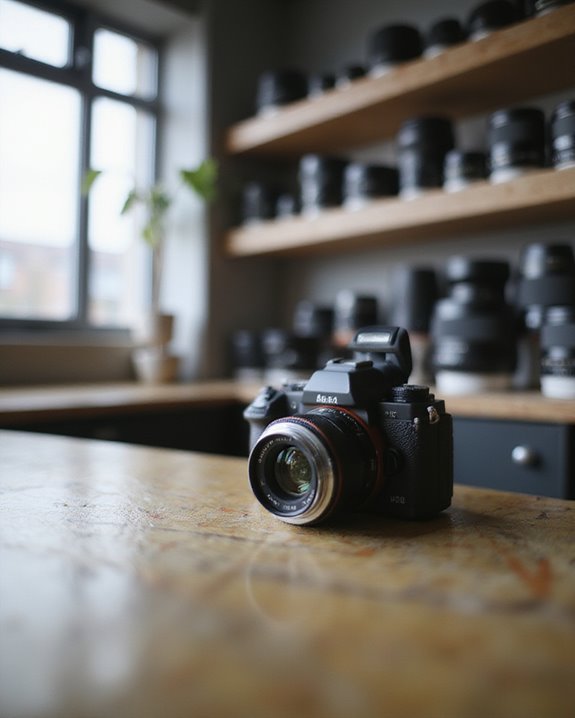Cameras use various lenses depending on photography needs, with three main types dominating the market: prime, zoom, and specialized lenses. Prime lenses offer fixed focal lengths with superior sharpness and larger apertures (f/1.4-f/1.8), while zoom lenses provide flexible focal ranges (like 24-70mm) for diverse shooting scenarios. Wide-angle lenses (under 35mm) capture expansive scenes, and telephoto lenses (over 70mm) magnify distant subjects. The choice ultimately depends on subject matter, lighting conditions, and desired creative effects.
Key Takeaways
- Standard zoom lenses (24-70mm) are most common for everyday photography, balancing versatility and image quality.
- Prime lenses offer superior sharpness and low-light performance with fixed focal lengths like 35mm or 50mm.
- Wide-angle lenses (14-35mm) are ideal for landscapes and architecture, capturing expansive scenes.
- Telephoto lenses (70mm+) are used for wildlife, sports, and portraits with subject magnification capabilities.
- Lens selection varies by photography style, with considerations for focal length, aperture, and mount compatibility.
Understanding Camera Lens Basics
The fundamentals of camera lenses provide a critical foundation for photographers seeking to master their equipment. A camera lens consists of several key components that work together to capture images with precision and clarity. Focal Length, measured in millimeters, represents the distance between the optical center of the lens and the image sensor when focused at infinity, determining the angle of view and magnification capabilities. Aperture Settings control light input through adjustable openings, directly impacting the depth of field in photographs. Many modern lenses feature an A/M switch that toggles between automatic and manual focusing modes, allowing photographers to select their preferred method of operation depending on shooting conditions and creative requirements. Additionally, understanding the aperture and its influence on light sensitivity can help photographers select the appropriate lens for different environments and desired effects.
Prime Lenses: Features and Benefits
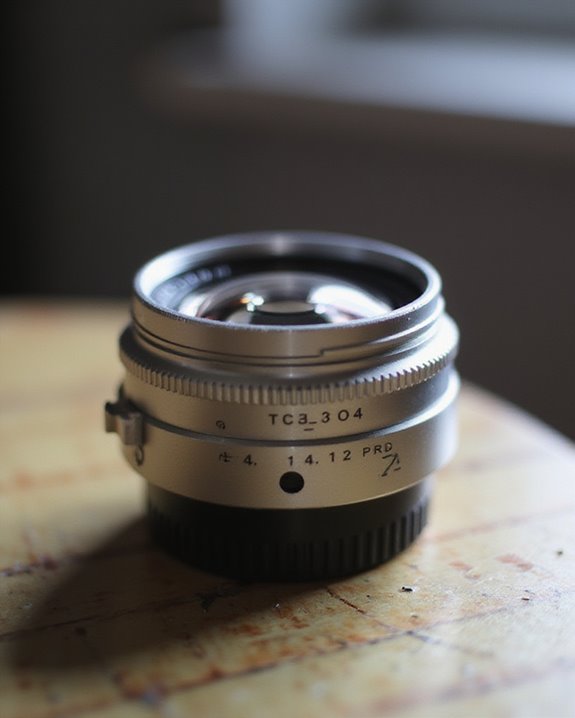
Among specialized lens options, prime lenses represent a foundational choice for photographers who prioritize optical excellence over mechanical versatility. These fixed focal length optics deliver exceptional Prime Sharpness from edge to edge, resulting from their simplified construction with fewer glass elements than zoom counterparts. Their larger maximum apertures, typically ranging from f/1.4 to f/1.8, excel in low-light environments while creating distinctive Bokeh Effects that beautifully isolate subjects from backgrounds.
The absence of zoom mechanisms makes prime lenses particularly lightweight and compact, ideal for travel and street photography where mobility matters. Despite their lack of variable focal length, prime lenses compensate with superior optical quality, reduced distortion, and enhanced creative control through precise depth of field manipulation. Their mechanical simplicity also contributes to faster autofocus and improved durability over time.
Zoom Lenses: Versatility in Photography
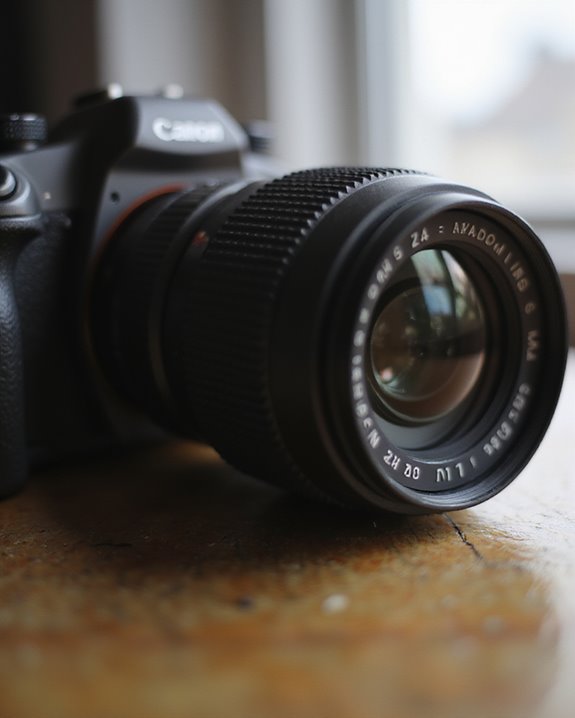
When versatility defines a photographer’s needs, zoom lenses emerge as indispensable tools in the modern camera bag, offering dynamic focal length flexibility without changing equipment. These lenses span continuous focal ranges, from standard zooms (24-70mm) that match human visual perception to superzooms covering wide-angle to telephoto perspectives, enabling photographers to frame diverse subjects precisely regardless of distance constraints. Recent Zoom Innovations have substantially narrowed the performance gap with prime lenses, with manufacturers like TAMRON optimizing designs for compactness while maintaining exceptional image quality. Photographers can leverage zoom capabilities for Creative Effects, manipulating perspective compression and depth without physically repositioning. In demanding scenarios such as sports events, wildlife photography, or travel, zoom lenses prove invaluable, eliminating frequent lens changes while providing optical quality that meets professional standards in varied lighting conditions. Additionally, advances in image stabilization systems have further enhanced handheld shooting capabilities across various focal lengths.
Wide-Angle Lenses for Expansive Shots

Capturing the grandeur of sweeping landscapes, architectural marvels, and dramatic interiors becomes possible through wide-angle lenses, optical instruments specifically designed with focal lengths of 35mm or shorter to provide photographers with greatly expanded fields of view. These versatile tools excel at Wide Framing, allowing users to encompass vast scenes without requiring extreme distance from subjects. Advanced wide-angle lenses incorporate distortion control elements, which help minimize vignetting and edge curvature, resulting in more natural and true-to-life images. Technical advantages include exceptional depth of field, keeping both near and distant elements in sharp focus simultaneously. Photographers commonly employ these lenses for landscape photography, architectural documentation, interior spaces, cityscapes, and astrophotography, where their ability to capture expansive scenes proves invaluable.
Standard Lenses for Everyday Photography
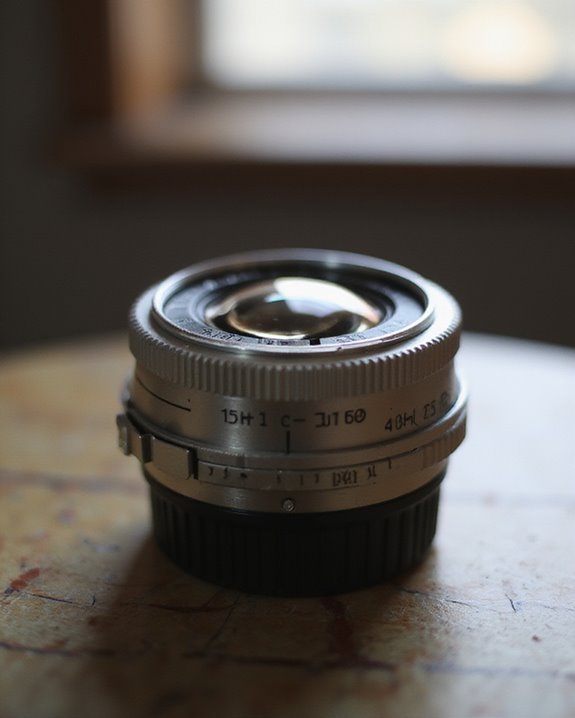
Standard lenses serve as the photographic industry’s equivalent to the human eye, offering focal lengths around 50mm that produce images with natural perspective and proportions similar to our normal vision. These versatile optics excel in various photography genres, from portraits to street photography, with popular models including the Canon EF 50mm f/1.8 STM and Nikon AF-S 50mm f/1.8G. Their wide apertures enhance low-light performance while accommodating various lens filters for creative effects.
Prime standard lenses typically deliver superior focus speed and image sharpness compared to zoom alternatives, though manufacturers also offer high-quality zoom options like the 24-70mm range for photographers requiring flexibility. When selecting a standard lens, photographers should consider budget constraints, brand compatibility, and intended use, weighing the advantages of fixed focal length primes against the versatility of zoom lenses for everyday documentation.
Telephoto Lenses: Bringing Distant Subjects Closer

Telephoto lenses represent a fundamental category in photography equipment, characterized by their ability to magnify distant subjects through longer focal lengths typically exceeding 60mm. These specialized optics create distinct lens compression, making distant elements appear closer together while maintaining proportional relationships between subjects. Available in medium (70-135mm), normal (135-400mm), and super telephoto (400mm+) variants, these lenses excel in various applications including portrait, wildlife, and sports photography.
Professional photographers value telephoto lenses for their bokeh effects, creating smooth, pleasing background blur that isolates subjects effectively. The technical design incorporates specialized lens groups that allow for a physical length shorter than the actual focal length. This engineering achievement provides photographers with manageable equipment that delivers exceptional reach, minimal distortion, and creative depth-of-field control across numerous photographic scenarios.
Specialized Lenses for Unique Photography Needs

Beyond conventional optics, specialized lenses offer photographers extraordinary creative possibilities for capturing distinctive images that standard equipment cannot achieve. These purpose-built tools address specific photographic challenges through innovative designs and optical properties. Tilt-shift lenses manipulate the plane of focus, while fisheye optics create dramatic 180°+ perspectives with characteristic spherical distortion.
For extreme close-up work, dedicated macro lenses provide true 1:1 reproduction ratios, often complemented by bellows systems for even greater magnification. Pinhole Techniques employ minimalist optics to create dreamlike images with infinite depth of field, mimicking photography’s earliest applications. Underwater Optics feature hydrophobic coatings and pressure-resistant seals, enabling photographers to capture aquatic environments without damage to equipment. Other specialized adaptations include IR-converted lenses for infrared photography and anamorphic adapters that produce cinematic widescreen aspect ratios.
Choosing the Right Lens for Your Photography Style

Selecting the right lens for one’s photographic endeavors requires careful consideration of both technical specifications and creative vision, as the lens choice fundamentally shapes the final image more than almost any other equipment decision. Different photography styles demand specific focal lengths, with landscape photographers typically preferring wide-angle lenses (14-35mm), while portrait photographers benefit from 50-100mm options for flattering facial proportions.
Lifestyle factors greatly influence lens selection, with travel photographers often gravitating toward versatile 24-70mm standard zooms that balance portability with range. Cultural aspects also affect choices, particularly in documentary photography where unobtrusive prime lenses allow photographers to capture authentic moments without intimidating subjects. Budget considerations remain paramount, with options ranging from affordable $100 beginner lenses to professional-grade glass exceeding $2,000, making rental an attractive alternative for occasional specialized needs.
Lens Compatibility Across Camera Brands
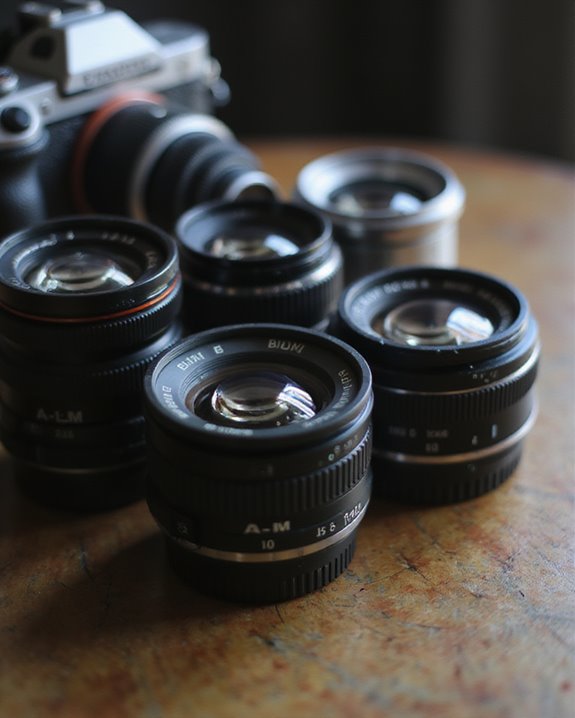
The intricate world of lens compatibility presents photographers with both opportunities and challenges when mixing equipment across different camera brands. Each manufacturer employs unique mounting systems, with Canon utilizing EF/RF mounts, Nikon featuring F/Z mounts, and Sony implementing FE-mount technology, creating fundamental Mount Differences that prevent direct interchangeability.
Photographers seeking cross-brand functionality commonly turn to adapters, though Adapter Quality greatly impacts performance results. High-quality adapters maintain most functionality, while budget options may compromise autofocus speed, aperture control, or image stabilization. Additionally, using adapted lenses often introduces crop factors that alter effective focal lengths—Sony APS-C cameras, for instance, apply a 1.5x crop to full-frame lenses. While third-party manufacturers like Sigma and Tamron offer lenses in multiple mount options, native brand-specific lenses consistently deliver ideal performance without compromising critical electronic communications or optical alignment.
Budget-Friendly Lens Options for Beginners
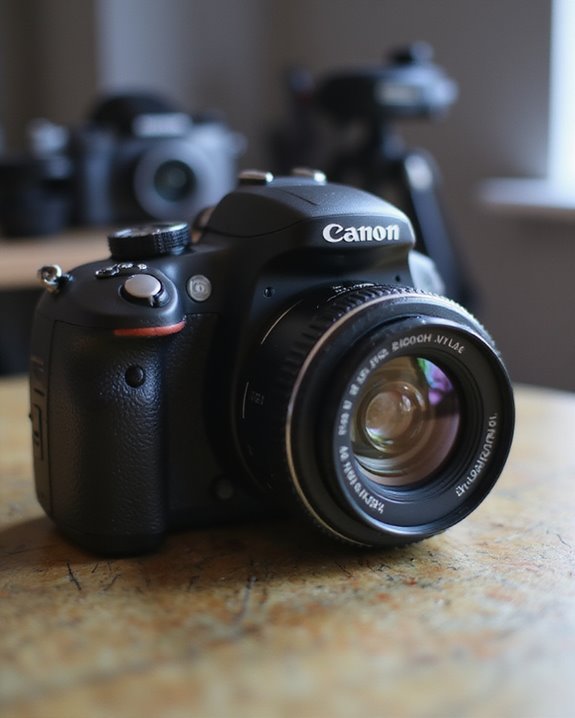
While lens compatibility presents technical complexities for experienced photographers, beginners face a different challenge—finding quality lenses that won’t break the bank. The market offers several affordable options that deliver impressive results without compromising essential features. Prime lenses like the Canon EF 50mm f/1.8 STM and Nikon’s “Nifty Fifty” provide excellent image quality under $150, especially when purchased during seasonal sale events. For those seeking versatility, zoom lenses such as the Tamron 18-200mm f/3.5-6.3 offer all-in-one convenience at budget-friendly prices.
Refurbished options from manufacturer outlets frequently provide significant savings on popular models like the Sony 55-210mm f/4.5-6.3 OSS, which combines telephoto capabilities with image stabilization. Beginners should prioritize features like wide apertures, lightweight construction, and image stabilization to maximize their learning experience while staying within budget constraints.
Frequently Asked Questions
How Long Do Camera Lenses Typically Last Before Needing Replacement?
Camera lens longevity varies greatly. Professional lenses typically last 10-20+ years with proper care, while consumer models may need replacement after 5-10 years. Regular maintenance schedules can substantially extend operational lifespan.
Can Lens Coating Quality Affect Color Reproduction in Photographs?
High-quality lens coatings can increase light transmission by 3.7%. Coating effects greatly impact color reproduction, reducing color shifts and enhancing vibrancy in photographs by minimizing reflections and flare that would otherwise distort true colors.
How Does Weather Sealing in Lenses Compare Across Price Points?
Weather sealing varies greatly across price points. Budget sealing offers basic protection at lower costs, while premium lenses provide thorough sealing with superior materials. Price variations reflect the extent and quality of weather protection implemented.
What Causes Lens Breathing During Video Recording?
Ironically, cameras “breathe” not from exercise but mechanical design. Lens breathing occurs when internal elements shift during focusing, causing focal fluctuations that alter magnification and field of view, creating noticeable breathing effects during video recording.
Do Third-Party Lenses Affect Camera Autofocus Speed?
Third-party lenses can affect autofocus speed depending on their compatibility with the camera system. Lens performance varies between manufacturers, with some third-party options matching native lenses while others may exhibit slower focusing capabilities.


